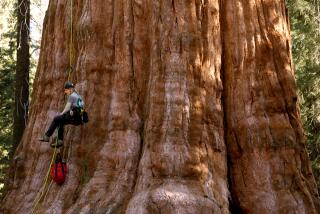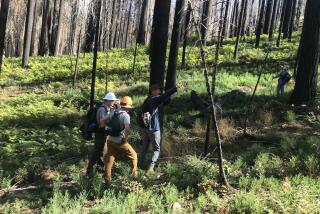Living Memorial to a Literate Man : Giant Trees Honor the Creator of Only Indian Alphabet
- Share via
SALLISAW, Okla. — Dillard Jordan held several cones filled with hundreds of giant Sequoia seeds that had just arrived in the mail from California.
“I’m going to plant the seeds, keep my fingers crossed and hope some will take hold,” said Jordan, 54, curator of the Oklahoma Historical Society’s Sequoyah Home Site.
Robert Evans, 46, a professional forester from Fresno, sent the seeds to Jordan after visiting the 10-acre park containing the original log cabin built by Sequoyah, who lived from the early 1770s (his birth date is unknown) to 1843.
The one-room cabin is housed in a stone structure erected by the Work Projects Administration in 1936. It is embraced by manicured lawns off a lonely country road surrounded by farms on the outskirts of Sallisaw in eastern Oklahoma.
During his visit, Evans asked Jordan if any of the trees named after Sequoyah were growing on the grounds. When the curator replied there are none, Evans said he would send him some giant Sequoia seeds as soon as he returned home, which he did.
Sequoyah, whose name is spelled various ways, is perhaps America’s most honored Indian.
He was never an Indian chief. But he did something, so far as is known, no other person in history had ever done before or since.
He conceived and perfected an 85-letter alphabet or syllabary for his nation that transformed his people from an illiterate to a literate group.
What makes the story of Sequoyah even more amazing is that he was illiterate at the time, unable to read or write English or any other language.
For that remarkable accomplishment Sequoyah’s memory is honored in many ways: Sequoia National Park and Sequoia National Forest in California, Mt. Sequoyah in the Cherokee National Forest on the Tennessee-North Carolina border.
Largest and Tallest
Sequoiadendron Giganteum or giant Sequoia, the world’s largest living things, are named after Sequoyah. So are the world’s tallest living things, Sequoia sempervirens , the giant redwoods of the Pacific Coast.
The largest known living tree on Earth is a Sequoiadendron Giganteum , the 3,500-plus-year-old German Gen. Sherman in Sequoia National Park with a height of 275 feet and a circumference at the base of 103 feet. It is so big, 100 five-room houses could be constructed from its lumber.
The tallest redwood structure stretches 362 feet toward the heavens in Humboldt Redwood State Park. The redwood is California’s state tree.
In 1905, a convention was held in Muskogee and a constitution was written--and later approved by voters--to form a new state to be called Sequoyah. But the attempt for statehood was premature.
Two years later it did happen but the new state was called not Sequoyah, as originally voted, but Oklahoma, a Choctaw Indian word meaning Red People.
There are schools, streets and buildings named after Sequoyah. The county where he lived in Oklahoma from 1828 to the time of his death carries his name, Sequoyah County.
In Washington, in the Hall of Statuary where each state is entitled to honor its two most outstanding personalities, Oklahoma salutes Sequoyah and Will Rogers, both Cherokee Indians.
Hanging in the Rotunda of Okalahoma’s Capitol is Charles Banks Wilson’s bigger-than-life painting of Sequoyah wearing a red turban (trademark of the Cherokees of his day), a long-stemmed pipe hanging from his mouth.
He is dressed in a long coat, long shirt, buckskin pants and moccasins and carries a walking stick. He is shown holding a scroll with the 85 letters of the Cherokee alphabet. Behind him in the painting is his log cabin at Skin Bayou on the outskirts of Sallisaw.
There also are statues to Sequoyah in Tulsa, Anadarko and Sallisaw, Okla., and at Calhoun, Ga.
In the Cherokee National Capitol at Tahlequah, Okla., Durbin Feeling, 39, conducts regular classes in reading and writing the Cherokee language in Sequoyah’s script.
“We Cherokees have the only Indian alphabet in America, yet, in recent years we have been neglecting this unique treasure. My plan is to get it back in circulation again,” Feeling said.
He noted that among today’s Cherokees, 60,000 in Oklahoma--most living in 14 counties in the northeastern corner of the state--and 8,500 living in North Carolina, about one-third speak their native language, 15% are able to read it written in Sequoyah’s syllabary and only 5% are able to write it using the 85 Cherokee letters.
Feeling instructs potential teachers of the alphabet who then go out into Cherokee villages to teach reading and writing Cherokee in churches, community centers, adult education classes, primary schools and high schools.
During the 12 years he spent creating his alphabet--from 1809 to 1821--Sequoyah came up with a particular letter for each sound in the Cherokee language.
Although he neither spoke nor read English, he borrowed many of his letters right side up and upside down from the English alphabet without regard to pronunciation. In Cherokee, the letters DHA are pronounced like the Spanish word amigo, D sounding like A , H like me and A sounding like go .
Among those attending Feeling’s classes are J. B. Dreadfulwater, 53, a schoolteacher; the Rev. Jess French, 45, a Cherokee pastor of the Rocky Ford Baptist Church; Faye Tehee, 26, a housewife; and Charlie Soap, 40, community development director for the Cherokee Nation.
“When members of my generation were growing up, we were told by our parents to forget the Indian language and concentrate on English in order to succeed,” Dreadfulwater said.
‘Something Truly Special’
“Learning English, of course, is vital. We must have it. But being bilingual is a plus. And, knowing how to read and write in the only alphabet ever developed in America is something truly special for the Cherokee people.”
French takes the knowledge of Sequoyah’s alphabet from Feelings’ class back to his parishioners. Tehee meets with several of her friends on weekends, teaching them the 85 characters in Sequoyah’s syllabary.
Soap passes along his ability to write the language of the Cherokees to fellow employees in informal sessions after work. “I really feel good being able to read and write Sequoyah’s gift to our people,” Soap said. “It’s a fulfillment of my culture. Durbin Feeling is generating a lot of positive reaction to his campaign to revive the written language of the Cherokees.”
Even though he had no schooling, Sequoyah realized reading and writing was the magic that would turn the tide for his people.
He was scorned and ridiculed by his family, friends and fellow tribesmen who could not understand his motive. They thought he was practicing black magic or another evil activity that would bring the wrath of the gods upon the Cherokees.
His wife destroyed his bark carvings; a log cabin in which he lived and worked in North Carolina was burned. But Sequoyah persisted. And, because of Sequoyah’s alphabet, the Cherokees became the most advanced Indians in America in the 19th Century.
Newspapers and books were published on printing presses using the 85 Cherokee letters. The Constitution, laws of the Cherokee Nation and resolutions of its national council were all printed in Cherokee and circulated among all its people.
At their capital at Tahlequah, the Cherokees formed a government modeled after the U.S. government. They erected a capitol for tribal officers and offices, a Supreme Court building, a national prison.
A national public school system was established by the Cherokees in 1841 and, by the time of statehood, consisted of 130 primary and secondary schools.
The first school for girls west of the Mississippi was the Cherokee Female Seminary at Tahlequah, opened in 1851, with instructions for Indian girls in Latin, algebra, botany, music, geography, grammar. A similar school was operated for boys.
Cherokees became governors, U.S. senators, members of Oklahoma’s Legislature and Supreme Court and business leaders. To this day, the Cherokee tribe is one of the most progressive in America.
Sequoyah was half white, half Cherokee. He used both his Cherokee name, Sequoyah (also spelled Sequoya, Sequoia or Sikwayi) and the English name George Gist (sometimes spelled Giss, Gust or Guess).
It is generally accepted that his father was Nathanial Gist, a friend of George Washington who spent many years among the Cherokees as a soldier.
Gist, a colonel in the Continental Army, was sent by Washington to the Cherokees to secure the best warriors to fight the British in the Revolutionary War.
It was during one of his visits to Cherokee country that Gist is believed to have had an affair with an Indian woman and fathered Sequoyah.
Gist had several daughters, a son-in-law named Francis Preston Blair who was editor of the Washington Globe, and two prominent grandsons--Montgomery Blair, Lincoln’s postmaster general, and Frances P. Blair Jr., a U.S. senator from Missouri whose home is the famous Blair House across from the White House.
But it was a son that Nathanial Gist never acknowledged who left an indelible mark on America--Sequoyah.
In 1842, Sequoyah left his log cabin at Skin Bayou to lead a small party including his son and half a dozen of his tribesmen in search of a lost band of Cherokees in northern Mexico.
A year later he died of natural causes in the village of the Mexican Cherokees and was buried by his son and companions in a nearby cave.
The Cherokee Tribal Council has sponsored several unsuccessful expeditions in search of Sequoyah’s remains in recent years. Cherokees would like to have the remains of their most famous tribal member reinterred in Tahlequah. But his grave has never been found.
More to Read
Sign up for Essential California
The most important California stories and recommendations in your inbox every morning.
You may occasionally receive promotional content from the Los Angeles Times.













